key MITSUBISHI OUTLANDER 2019 Owner's Manual (in English)
[x] Cancel search | Manufacturer: MITSUBISHI, Model Year: 2019, Model line: OUTLANDER, Model: MITSUBISHI OUTLANDER 2019Pages: 451, PDF Size: 58.02 MB
Page 5 of 451
![MITSUBISHI OUTLANDER 2019 Owners Manual (in English) Instruments and controls
Overview 1-2
1
Audio (if so equipped) [Refer to the separate owner’s manual.] Multi Around Monitor (if
so equipped) P.5-146
Hazard warning flasher switch P.5-220
Electr MITSUBISHI OUTLANDER 2019 Owners Manual (in English) Instruments and controls
Overview 1-2
1
Audio (if so equipped) [Refer to the separate owner’s manual.] Multi Around Monitor (if
so equipped) P.5-146
Hazard warning flasher switch P.5-220
Electr](/img/19/34859/w960_34859-4.png)
Instruments and controls
Overview 1-2
1
Audio (if so equipped) [Refer to the separate owner’s manual.] Multi Around Monitor (if
so equipped) P.5-146
Hazard warning flasher switch P.5-220
Electric rear window defogger switch P.5-227 Wiper deicer switch (if so equipped) P.5-226 Fuel tank filler door release lever P. 3 - 3
Air conditioner P.7-5 Hood release lever P. 9 - 3
Floor console box P.5-242 Arm rest 12 V power outlet (if so equipped) P.5-232 USB input terminal (if so equipped) P.5-229
Cup holder P.5-245
12 V power outlet P.5-232
Power liftgate main switch (if so equipped) P.5-39
Key slot (if so equipped) P.5-26
Passenger’s vents P. 7 - 2
Passenger’s airbag off indicator P.4-40
Front passenger seat belt warning light P.4-23
Heated steering wheel switch (if so equipped) P.5-228
Blind Spot Warning (BSW) switch (if so equipped) P.5-126
USB input terminal (if so equipped) P.5-229
USB input terminal P.5-229
2nd seat vents (if so equipped) P. 7 - 2
BK0264300US.book 2 ページ 2018年2月28日 水曜日 午後5時16分
Page 11 of 451
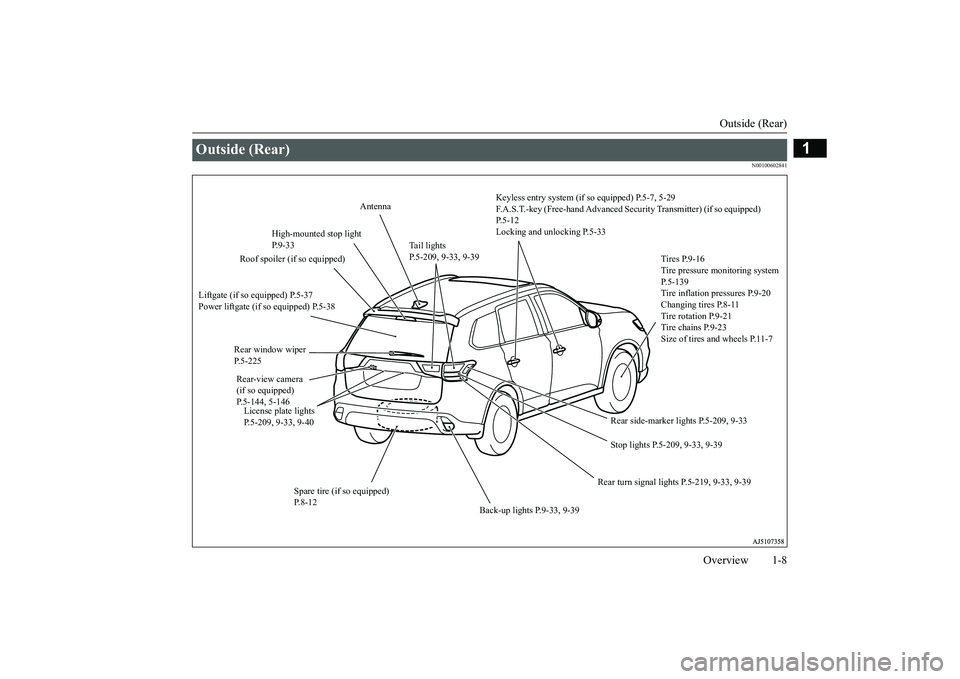
Outside (Rear)
Overview 1-8
1
N00100602841
Outside (Rear)
Keyless entry system (if so equipped) P.5-7, 5-29 F.A.S.T.-key (Free-hand Advanced Se
curity Transmitter) (if so equipped)
P.5-12 Locking and unlocking P.5-33
Tires P.9-16 Tire pressure monitoring system P.5-139Tire inflation pressures P.9-20Changing tires P.8-11 Tire rotation P.9-21 Tire chains P.9-23Size of tires and wheels P.11-7
Stop lights P.5-209, 9-33, 9-39
Rear turn signal lights P.5-219, 9-33, 9-39
Spare tire (if so equipped) P.8-12
Back-up lights P.9-33, 9-39
License plate lights P.5-209, 9-33, 9-40 Rear-view camera (if so equipped) P.5-144, 5-146 Rear window wiper P.5-225
High-mounted stop light P.9-33
Antenna
Liftgate (if so equipped) P.5-37 Power liftgate (if so equipped) P.5-38
Rear side-marker lights P.5-209, 9-33
Tail lights P.5-209, 9-33, 9-39
Roof spoiler (if so equipped)
BK0264300US.book 8 ページ 2018年2月28日 水曜日 午後5時16分
Page 17 of 451

If this problem occurs...
Quick index 2-5
2
N00200902063
If this problem occurs...
Problem
Do this
Ref. Page
Unable to turn the key. (except for vehicles equipped with the F.A.S.T.-key)
Will not turn from “LOCK” to “ACC”.
(Vehicles with steering lock system)
Turn the key while turning the steering wheel in either direction.
P. 5-65
Will not turn from “ACC” to “OFF” or “LOCK”. Check the position of the selector lever. The key cannot be removed unless the selector
lever is set to the “P” (PARK) position.
On vehicles with stee
ring lock system, push the key in
at the “ACC” posi
tion and keep it
depressed until it is turned to the “LOCK” position.
P. 5-64
The engine does not start when the engine switch is pressed. (for vehicles equipped with the F. A . S . T. - k e y )
Make sure the F.A.S.T.-key is in the vehicle. Make sure the selector lever is in the “P” (P
ARK) position, and then press the engine switch
while depressing the brake pedal.
P. 5-24
BK0264300US.book 5 ページ 2018年2月28日 水曜日 午後5時16分
Page 18 of 451
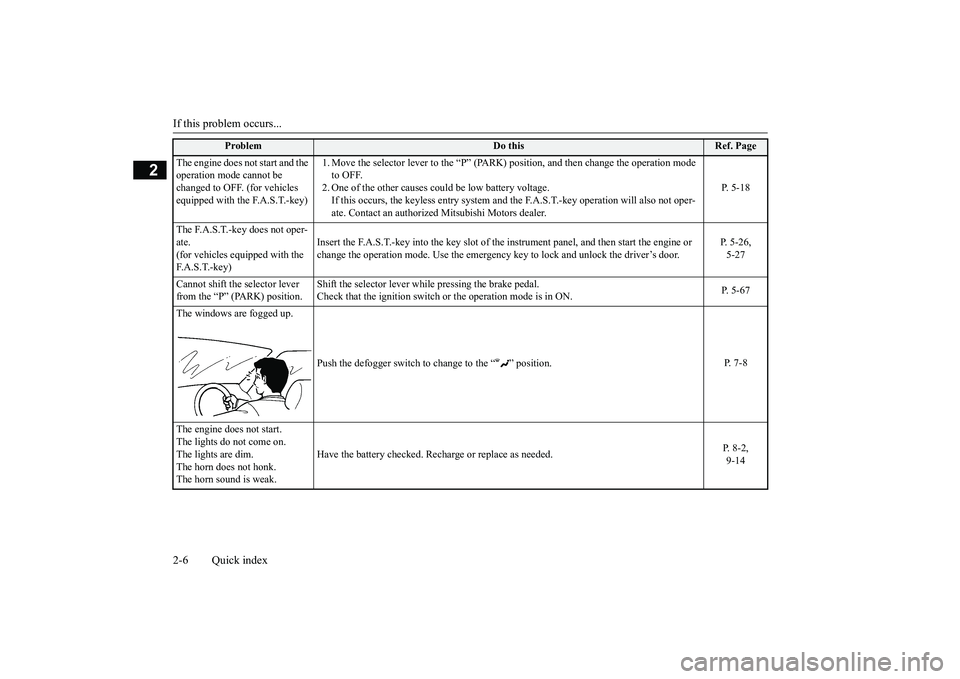
If this problem occurs... 2-6 Quick index
2
The engine does not start and the operation mode cannot be changed to OFF. (for vehicles equipped with the F.A.S.T.-key)
1. Move the selector le
ver to the “P” (PARK) position, a
nd then change the operation mode
to OFF.2. One of the other causes c
ould be low battery voltage.
If this occurs, the keyless entr
y system and the F.A.S.T.-key
operation will also not oper-
ate. Contact an authorized Mitsubishi Motors dealer.
P. 5-18
The F.A.S.T.-key does not oper- ate. (for vehicles equipped with the F. A . S . T. - k e y )
Insert the F.A.S.T.-key into the key slot of the
instrument panel, and then start the engine or
change the operation mode. Use
the emergency key to lock and unlock the driver’s door.
P. 5-26, 5-27
Cannot shift the selector lever from the “P” (PARK) position.
Shift the selector lever while pressing the brake pedal. Check that the ignition switch
or the operation mode is in ON.
P. 5-67
The windows are fogged up.
Push the defogger switch to
change to the “ ” position.
P. 7-8
The engine does not start. The lights do not come on.The lights are dim. The horn does not honk. The horn sound is weak.
Have the battery checked. Rech
arge or replace as needed.
P. 8-2, 9-14
Problem
Do this
Ref. Page
BK0264300US.book 6 ページ 2018年2月28日 水曜日 午後5時16分
Page 52 of 451
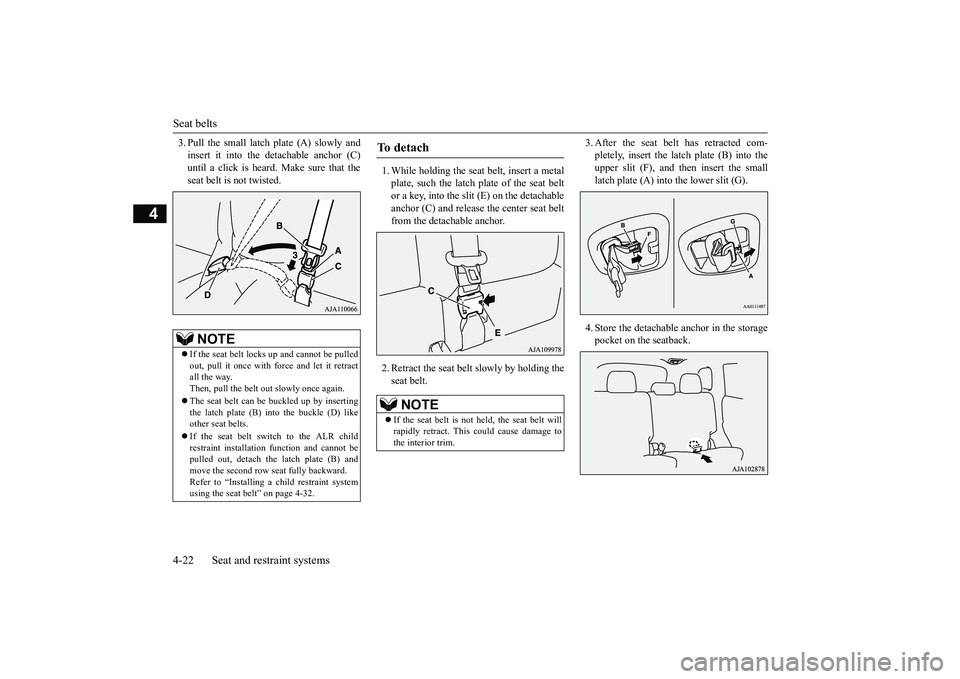
Seat belts 4-22 Seat and restraint systems
4
3. Pull the small latch plate (A) slowly and insert it into the detachable anchor (C)until a click is heard. Make sure that the seat belt is not twisted.
1. While holding the seat belt, insert a metal plate, such the latch plate of the seat belt or a key, into the slit (E) on the detachable anchor (C) and release the center seat beltfrom the detachable anchor. 2. Retract the seat belt slowly by holding the seat belt.
3. After the seat belt has retracted com- pletely, insert the latch plate (B) into theupper slit (F), and then insert the small latch plate (A) into the lower slit (G). 4. Store the detachable anchor in the storage pocket on the seatback.
NOTE
If the seat belt locks
up and cannot be pulled
out, pull it once with force and let it retract all the way.Then, pull the belt out
slowly once again.
The seat belt can be
buckled up by inserting
the latch plate (B) in
to the buckle (D) like
other seat belts. If the seat belt switch to the ALR child restraint installation
function and cannot be
pulled out, detach the
latch plate (B) and
move the second row seat fully backward. Refer to “Installing a child restraint system using the seat be
lt” on page 4-32.
To d e t a c h
NOTE
If the seat belt is not held, the seat belt will rapidly retract. This
could cause damage to
the interior trim.
BK0264300US.book 22 ページ 2018年2月28日 水曜日 午後5時16分
Page 56 of 451
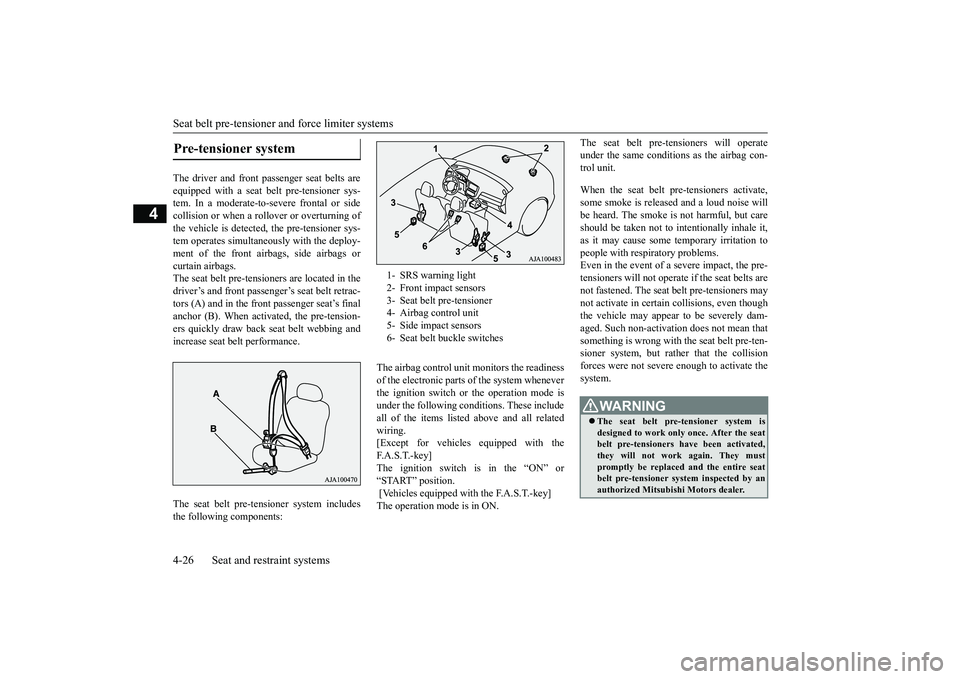
Seat belt pre-tensioner
and force limiter systems
4-26 Seat and restraint systems
4
The driver and front pa
ssenger seat belts are
equipped with a seat belt pre-tensioner sys- tem. In a moderate-to-severe frontal or sidecollision or when a rollover or overturning of the vehicle is detected, the pre-tensioner sys- tem operates simultaneous
ly with the deploy-
ment of the front airb
ags, side airbags or
curtain airbags. The seat belt pre-tensi
oners are located in the
driver’s and front passenger’s seat belt retrac- tors (A) and in the front
passenger se
at’s final
anchor (B). When activated, the pre-tension- ers quickly draw back seat belt webbing and increase seat belt performance. The seat belt pre-tens
ioner system includes
the following components:
The airbag control unit monitors the readiness of the electronic parts of the system whenever the ignition switch or the operation mode is under the following conditions. These includeall of the items listed
above and all related
wiring. [Except for vehicles
equipped with the
F. A . S . T. - k e y ] The ignition switch is in the “ON” or “START” position. [Vehicles equipped with the F.A.S.T.-key] The operation mode is in ON.
The seat belt pre-tens
ioners will operate
under the same conditions
as the airbag con-
trol unit. When the seat belt pre-tensioners activate, some smoke is released
and a loud noise will
be heard. The smoke is
not harmful, but care
should be taken not to in
tentionally inhale it,
as it may cause some
temporary irritation to
people with respiratory problems.Even in the event of a severe impact, the pre- tensioners will
not operate if the seat belts are
not fastened. The seat be
lt pre-tensioners may
not activate in certai
n collisions, even though
the vehicle may appear
to be severely dam-
aged. Such non-activation does not mean that something is wrong with
the seat belt pre-ten-
sioner system, but rather that the collisionforces were not severe
enough to activate the
system.
Pre-tensioner system
1- SRS warning light 2- Front impact sensors 3- Seat belt
pre-tensioner
4- Airbag control unit5- Side impact sensors 6- Seat belt
buckle switches
WA R N I N GThe seat belt pre-tensioner system is designed to work only
once. After the seat
belt pre-tensioners have been activated, they will not work again. They must promptly be replaced and the entire seatbelt pre-tensioner system inspected by an authorized Mitsubis
hi Motors dealer.
BK0264300US.book 26 ページ 2018年2月28日 水曜日 午後5時16分
Page 64 of 451
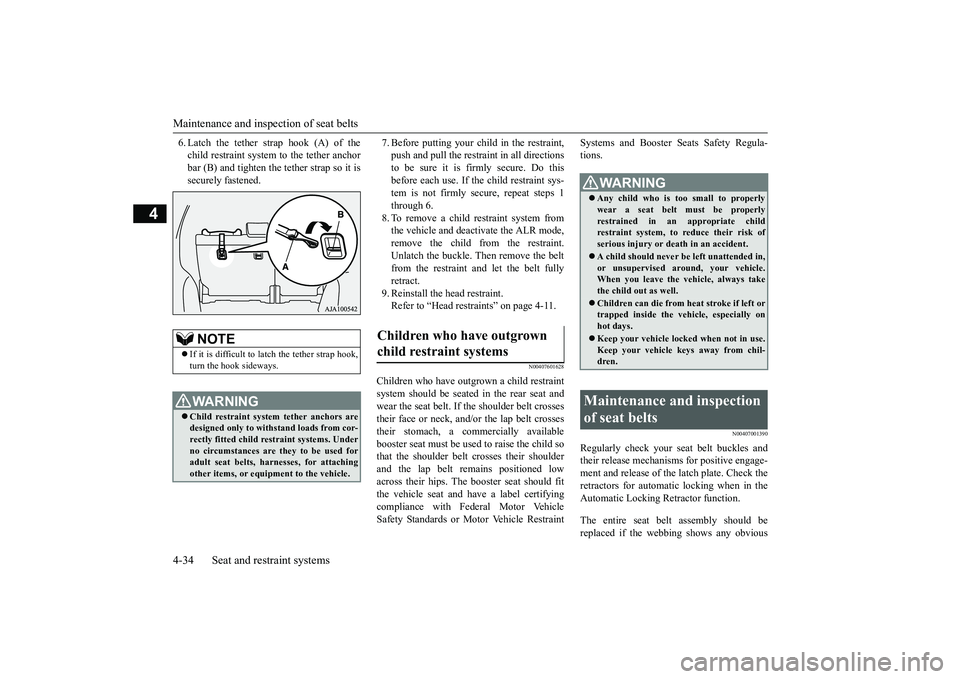
Maintenance and inspection of seat belts 4-34 Seat and restraint systems
4
6. Latch the tether strap hook (A) of the child restraint system to the tether anchorbar (B) and tighten the tether strap so it is securely fastened.
7. Before putting your child in the restraint, push and pull the restraint in all directionsto be sure it is firmly secure. Do this before each use. If the child restraint sys- tem is not firmly s
ecure, repeat steps 1
through 6. 8. To remove a child restraint system from the vehicle and deac
tivate the ALR mode,
remove the child from the restraint. Unlatch the buckle. Th
en remove the belt
from the restraint and let the belt fully retract. 9. Reinstall the head restraint.Refer to “Head restraints” on page 4-11.
N00407601628
Children who have outgrown a child restraint system should be seated in the rear seat and wear the seat belt. If the shoulder belt crossestheir face or neck, and/
or the lap belt crosses
their stomach, a commercially available booster seat must be used to raise the child sothat the shoulder belt
crosses their shoulder
and the lap belt remains positioned low across their hips. The booster seat should fitthe vehicle seat and ha
ve a label certifying
compliance with Federal Motor Vehicle Safety Standards or Mo
tor Vehicle Restraint
Systems and Booster Se
ats Safety Regula-
tions.
N00407001390
Regularly check your seat belt buckles andtheir release mechanisms for positive engage-ment and release of the latch plate. Check the retractors for automatic locking when in the Automatic Locking Retractor function. The entire seat belt assembly should be replaced if the webbing shows any obvious
NOTE
If it is difficult to la
tch the tether strap hook,
turn the hook sideways.WA R N I N G Child restraint system tether anchors are designed only to with
stand loads from cor-
rectly fitted child restraint systems. Underno circumstances are they to be used for adult seat belts, harnesses, for attaching other items, or equipment to the vehicle.
Children who have outgrown child restraint systems
WA R N I N G Any child who is too small to properly wear a seat belt
must be properly
restrained in an appropriate child restraint system, to reduce their risk ofserious injury or de
ath in an
accident.
A child should never be
left unattended in,
or unsupervised around, your vehicle. When you leave the ve
hicle, always take
the child out as well. Children can die from heat stroke if left or trapped inside the vehicle, especially onhot days. Keep your vehicle locked when not in use. Keep your vehicle keys away from chil- dren.
Maintenance and inspection of seat belts
BK0264300US.book 34 ページ 2018年2月28日 水曜日 午後5時16分
Page 68 of 451
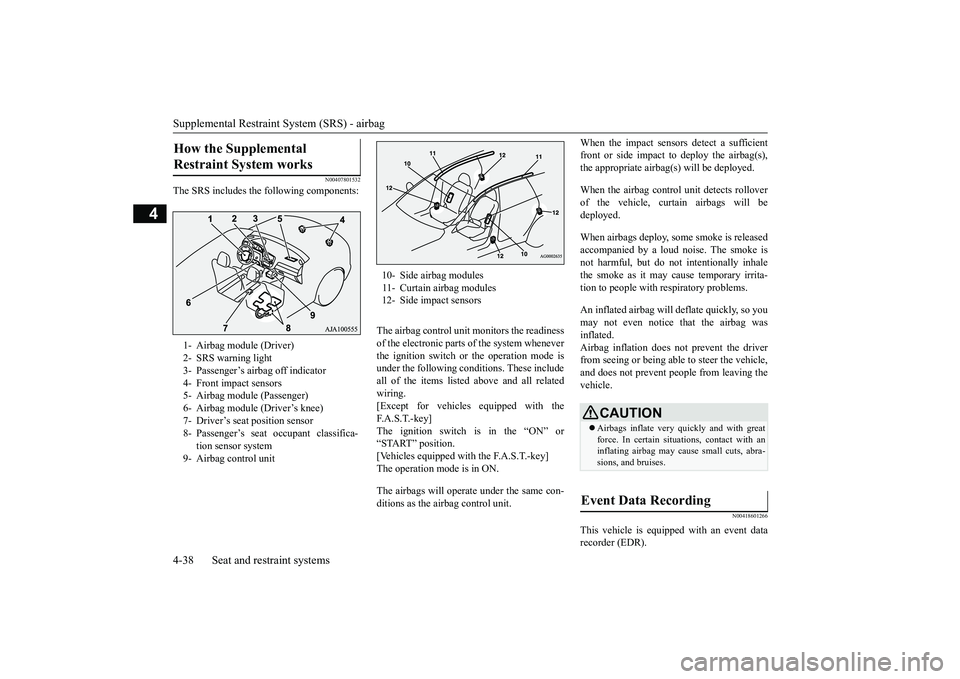
Supplemental Restraint System (SRS) - airbag 4-38 Seat and restraint systems
4
N00407801532
The SRS includes the following components:
The airbag control unit monitors the readiness of the electronic parts of the system whenever the ignition switch or the operation mode is under the following conditions. These include all of the items listed
above and all related
wiring.[Except for vehicles
equipped with the
F. A . S . T. - k e y ] The ignition switch is in the “ON” or“START” position. [Vehicles equipped with the F.A.S.T.-key] The operation mode is in ON. The airbags will opera
te under the same con-
ditions as the airbag control unit.
When the impact sensors detect a sufficient front or side impact to deploy the airbag(s),the appropriate airbag
(s) will be deployed.
When the airbag control unit detects rollover of the vehicle, curtain airbags will be deployed. When airbags deploy, so
me smoke is released
accompanied by a loud noise. The smoke is not harmful, but do not intentionally inhale the smoke as it may ca
use temporary irrita-
tion to people with respiratory problems. An inflated airbag will deflate quickly, so you may not even notice that the airbag wasinflated. Airbag inflation does not prevent the driver from seeing or being able to steer the vehicle,and does not prevent people from leaving the vehicle.
N00418601266
This vehicle is equipped with an event data recorder (EDR).
How the Supplemental Restraint System works 1- Airbag module (Driver) 2- SRS warning light 3- Passenger’s airbag off indicator 4- Front impact sensors5- Airbag module (Passenger) 6- Airbag module (Driver’s knee) 7- Driver’s seat position sensor8- Passenger’s seat oc
cupant classifica-
tion sensor system
9- Airbag control unit
10- Side airbag modules11- Curtain airbag modules12- Side impact sensors
CAUTION Airbags inflate very quickly and with great force. In certain situ
ations, contact with an
inflating airbag may cause small cuts, abra- sions, and bruises.
Event Data Recording
BK0264300US.book 38 ページ 2018年2月28日 水曜日 午後5時16分
Page 70 of 451
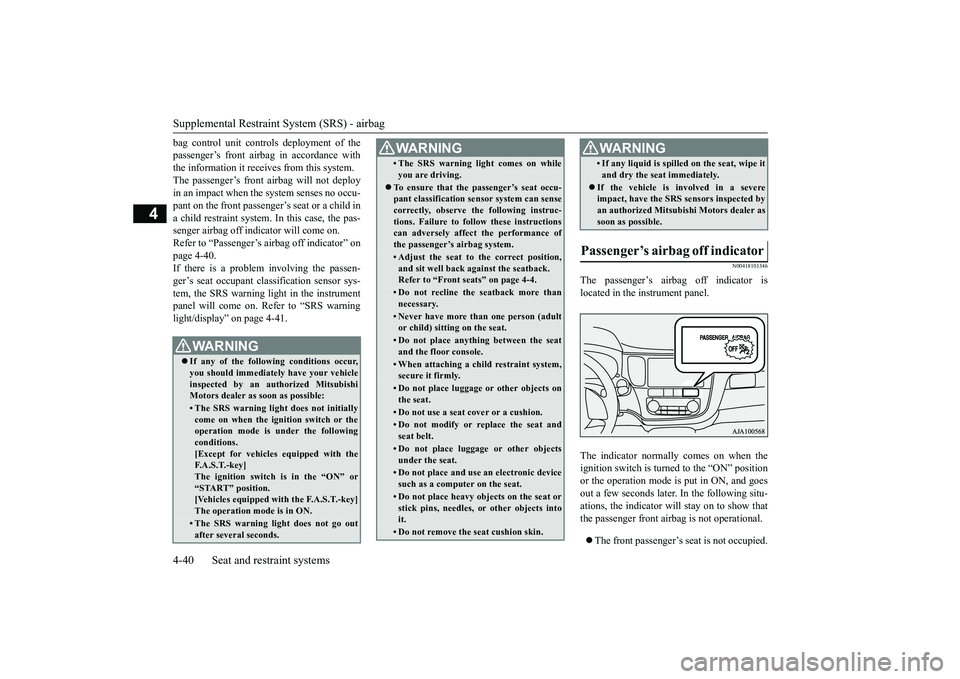
Supplemental Restraint System (SRS) - airbag 4-40 Seat and restraint systems
4
bag control unit controls deployment of the passenger’s front airbag in accordance withthe information it receives from this system. The passenger’s front airbag will not deploy in an impact when the system senses no occu-pant on the front passenger’s seat or a child in a child restraint system. In this case, the pas- senger airbag off indi
cator will come on.
Refer to “Passenger’s ai
rbag off indicator” on
page 4-40. If there is a problem involving the passen- ger’s seat occupant cl
assification sensor sys-
tem, the SRS warning light in the instrumentpanel will come on. Refer to “SRS warning light/display” on page 4-41.
N00418101346
The passenger’s airbag off indicator is located in the instrument panel. The indicator normally comes on when the ignition switch is turned to the “ON” position or the operation mode is put in ON, and goes out a few seconds later.
In the following situ-
ations, the indicator will stay on to show that the passenger front airb
ag is not operational.
The front passenger’s seat is not occupied.
WA R N I N GIf any of the follow
ing conditions occur,
you should immediatel
y have your vehicle
inspected by an au
thorized Mitsubishi
Motors dealer as soon as possible:• The SRS warning light does not initiallycome on when the ignition switch or the operation mode is under the followingconditions. [Except for vehicles equipped with the F. A . S . T. - k e y ]The ignition switch is in the “ON” or “START” position. [Vehicles equipped with the F.A.S.T.-key]The operation mode is in ON.• The SRS warning light does not go outafter several seconds.
• The SRS warning li
ght comes on while
you are driving.
To ensure that the passenger’s seat occu- pant classification sensor system can sense correctly, observe the following instruc-tions. Failure to follow these instructions can adversely affect
the performance of
the passenger’s airbag system.• Adjust the seat to the correct position,and sit well back
against the seatback.
Refer to “Front seats” on page 4-4.• Do not recline the seatback more thannecessary.• Never have more th
an one person (adult
or child) sitting on the seat.• Do not place anything between the seatand the floor console.• When attaching a child restraint system,secure it firmly.• Do not place luggage or other objects onthe seat.• Do not use a seat cover or a cushion.• Do not modify or re
place the seat and
seat belt.• Do not place luggage or other objectsunder the seat.• Do not place and use
an electronic device
such as a computer on the seat.• Do not place heavy obje
cts on the seat or
stick pins, needles, or other objects intoit.• Do not remove the seat cushion skin.WA R N I N G
• If any liquid is spilled on the seat, wipe itand dry the seat immediately.
If the vehicle is involved in a severe impact, have the SRS sensors inspected by an authorized
Mitsubishi Motors dealer as
soon as possible.
Passenger’s airbag off indicator
WA R N I N G
BK0264300US.book 40 ページ 2018年2月28日 水曜日 午後5時16分
Page 76 of 451
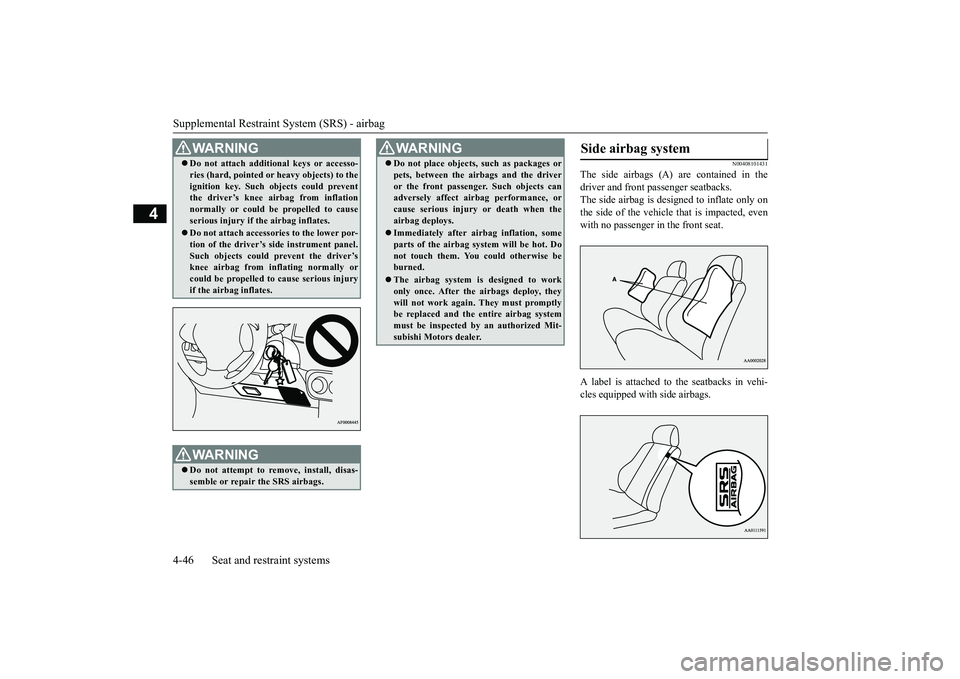
Supplemental Restraint System (SRS) - airbag 4-46 Seat and restraint systems
4
N00408101431
The side airbags (A) are contained in the driver and front passenger seatbacks. The side airbag is de
signed to inflate only on
the side of the vehicle that is impacted, even with no passenger in the front seat. A label is attached to the seatbacks in vehi- cles equipped with side airbags.
Do not attach addition
al keys or accesso-
ries (hard, pointed or
heavy objects) to the
ignition key. Such objects could preventthe driver’s knee ai
rbag from inflation
normally or could be propelled to cause serious injury if
the airbag inflates.
Do not attach accessories to the lower por- tion of the driver’s side instrument panel.Such objects could prevent the driver’s knee airbag from inflating normally or could be propelled to cause serious injuryif the airbag inflates.WA R N I N G Do not attempt to remove, install, disas- semble or repair the SRS airbags.WA R N I N G
Do not place objects,
such as packages or
pets, between the airbags and the driveror the front passenger. Such objects canadversely affect ai
rbag performance, or
cause serious injury or death when the airbag deploys. Immediately after airbag inflation, some parts of the airbag syst
em will be hot. Do
not touch them. You could otherwise be burned. The airbag system is designed to work only once. After the
airbags deploy, they
will not work again. They must promptlybe replaced and the
entire airbag system
must be inspected by
an authorized Mit-
subishi Motors dealer.WA R N I N G
Side airbag system
BK0264300US.book 46 ページ 2018年2月28日 水曜日 午後5時16分